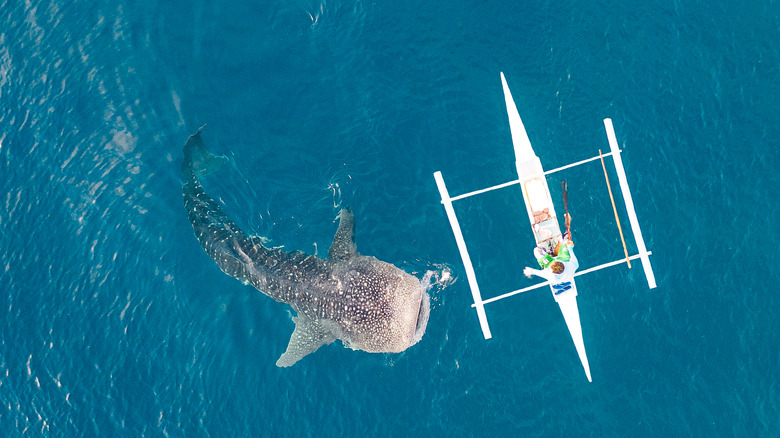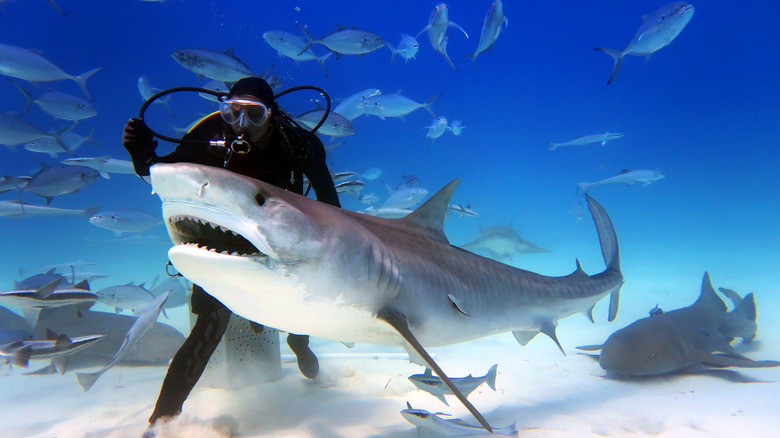What You Need To Know About Color-Changing Sharks
The great white shark is perhaps the most iconic deep-sea swimmer of all time. Nothing says summer quite like the classic "Jaws" theme song which subtly plays on their power to sneak up on prey, seemingly appearing from out of nowhere. They possess this power in real life, too, not just on the big screen. Viral photos and videos of close encounters with the creatures surface on the internet all the time (via Yahoo! News).
The great white shark's apex predator status is often attributed to size and speed. The Smithsonian Institution's Ocean website reports that great white sharks can craftily propel their bodies through the ocean depths at speeds of about 35 miles per hour. The males can grow up to 20 feet in length, though most average 11 to 13 feet long, and the females, to around 15 feet. Most weigh in between 1,500 and 4,000 pounds, though some grow as large as 2.5 tons, says Britannica. This is not to mention the fact that their five rows of more than 300 teeth on average can produce a bite force of 4,000 psi, making their jaws among the most powerful on the planet (per A-Z Animals). While these attributes are certainly nothing to bat an eyelash at, a new study suggests these sharks have an even more magical and potentially deadly quality: the ability to change color at will (via another posting at National Geographic).
Research suggests great white sharks can change colors from dark to light
Camouflage is one of the ocean's most mystifying tricks. Hypnotic cuttlefish ensnare prey in an array of color-changing light (via Oceana). And according to Live Science, tentacled cephalopods can change not only color but also texture to mimic just about every habitat they might be hiding out in. Some species of sharks possess a kind of bioluminescence that renders them glow-in-the-dark (via Mongabay).
But this new finding suggests that the infamous great white is perhaps not white at all — or at least not all the time. To be fair, a 1996 study produced similar results, but with hammerhead sharks, showing that they gradually grew darker amid deeper waters (per National Geographic). However, this new study delivers a murky, unexpected truth: The sharks are likely changing colors on purpose and at will. For deep sea swimmers, human and otherwise, such findings are a horse, or rather a shark, of a different color indeed.
Cameras, drones and decoys employed to capture the behavior
While the color-changing technique was something the researchers initially discovered by happenstance, National Geographic reports that South Africa's Wilderness Shark Research Unit utilized a wide variety of tools and methods to arrive at this new hypothesis once they realized what was happening under the surface. Shark biologist Ryan Johnson attests to taking hundreds of snapshots of the great white sharks moving over color boards.
Nature World News reports that scientists even tested shark's skin cells on a molecular level, and found that the skin responded to the melanocyte-stimulating hormone by darkening hues. While crafty procedures were used to collect the preliminary samples, including a drone, a remote-controlled boat, and a decoy seal, researchers still warn us not to go overboard with the discovery just yet.
The sample of sharks is too small to make the evidence conclusive as of late, according to Newsweek. However, the prospect of color-changing sharks is something these eager scientists can't wait to sink their teeth into. Shark geneticist Gibbs Kuguru claimed they would need to produce five to 15 more samples in the future.
The color-shifting is probably a hunting technique
In 1996, when color-shifting capabilities were observed in the scalloped hammerhead shark species, researchers thought the monstrous fish were simply getting suntans (via National Geographic). While the thought of sunbathing sharks is certainly entertaining, the new research emerging from the great white species suggests a much more understandable theory. The sharks are using selective hues to sneak up on their prey.
Michigan State University Museum researcher Michelle Jewell says this makes a great deal of logical sense, despite the fact that it was not previously discussed. "We didn't consider that this could potentially be something that they themselves are manipulating to get darker or to get lighter," she explained.
According to Nature World News, the motion, much like the shark itself, is subtle but deadly. The color change seems to take place when the great white sharks are breaching, which is a hunting technique they use to jump 10 feet in the air, in order to capture speedy prey such as seals (per Ocean).



